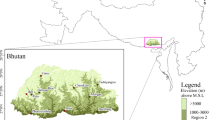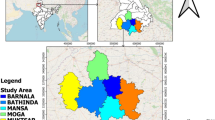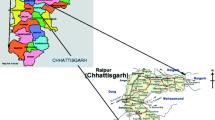Abstract
This study uses the Box–Cox transformation to improve the normalization procedure of the simplified standardized precipitation index (SSPI), utilizing the monthly precipitation of 45 stations distributed across Iran spanning from 1971 to 2017. The results showed that the Box–Cox transformation can reduce the skewness of the monthly precipitation aggregated at 1-, 3-, 6-, 9-, 12, and 24-month time scales to as close as zero, and successfully transforms them into an approximately normally distributed series. The normally distributed Box–Cox transformed precipitation series of the studied stations was then used to compute SSPI (SSPIBox–Cox) for the considered stations and time scales. For almost all the stations and time scales, the computed Shapiro and Wilk (S-W) test and the associated p value of the SSPIBox–Cox time series were found to be larger than the critical values of 0.96 and 0.1, respectively. For the majority of the stations, the mean and standard deviation of the SSPIBox–Cox computed for all the time scales were also close to 0.0 and unity, respectively. The mentioned statistics values suggest that the SSPIBox–Cox time series of almost all of the stations follow the standard normal distribution for all the time scales, except for 1- and 3-month time scales corresponding to the warm season calendar months of the stations located in the arid and hyper-arid areas. The results also show that the association between SSPIBox–Cox and the standardized precipitation index was considerably improved for all the stations and time scales when compared to the SSPI time series computed with the original SSPI procedure that uses a reformulation of the rainfall anomaly index for normalizing the data.















Similar content being viewed by others
References
Blain GC, Meschiatti MC (2015) Inadequacy of the gamma distribution to calculate the standardized precipitation index. Rev Bras Eng Agríc Ambient 19:1129–1135
Box GEP, Cox DR (1964) An analysis of transformations. J R Stat Soc: Ser B (methodol) 26:211–243
Farahmand A, AghaKouchak A (2015) A generalized framework for deriving nonparametric standardized drought indicators. Adv Water Resour 76:140–145
Guenang GM, Kamga FM (2014) Computation of the standardized precipitation index (SPI) and its use to assess drought occurrences in Cameroon over recent decades. J Appl Meteorol Climatol 53:2310–2324
Guenang GM, Komkoua MAJ, Pokam MW, Tanessong RS, Tchakoutio SA, Vondou A, Tamoffo AT, Djiotang L, Yepdo Z, Mkankam KF (2019) Sensitivity of SPI to distribution functions and correlation between its values at different time scales in Central Africa. Earth Syst Environ 3:203–214
Guttman NB (1998) Comparing the palmer drought index and the standardized precipitation index. J Am Water Resour Assoc 34:113–121
Guttman NB (1999) Accepting the standardized precipitation index: a calculation algorithm1. JAWRA J Am Water Resour Assoc 35:311–322
Hayes M, Svoboda M, Wall N, Widhalm M (2011) The Lincoln declaration on drought indices. Bull Am Meteorol Soc 92(4):485–488. https://doi.org/10.1175/2010BAMS3103.1
Husak GJ, Michaelsen J, Funk C (2007) Use of the gamma distribution to represent monthly rainfall in Africa for drought monitoring applications. Int J Climatol 27:935–944
Legates DR (1991) An evaluation of procedures to estimate monthly precipitation probabilities. J Hydrol 122:129–140
Lloyd-Hughes B, Saunders MA (2002) A drought climatology for Europe. Int J Climatol 22:1571–1592
Mckee T, Doesken N, Kleist J (1993) The relationship of drought frequency and duration to time scales
McKee TB, Doesken NJ, Kleist J (1995) Drought monitoring with multiple time scales. In: 9th conference on applied climatology, Dallas, TX, 15–20 Jan 1995
Moriasi DN, Arnold JG, Van Liew MW, Bingner RL, Harmel RD, Veith TL (2007) Model evaluation guidelines for systematic quantification of accuracy in watershed simulations. Trans ASABE 50:885–900
Nash JE, Sutcliffe JV (1970) River flow forecasting through conceptual models part I—a discussion of principles. J Hydrol 10:282–290
Ntale HK, Gan TY (2003) Drought indices and their application to East Africa. Int J Climatol 23:1335–1357
Pieper P, Düsterhus A, Baehr J (2020) A universal standardized precipitation index candidate distribution function for observations and simulations. Hydrol Earth Syst Sci 24:4541–4565
Quiring SM (2009) Monitoring drought: an evaluation of meteorological drought indices. Geogr Compass 3/1:64–88. https://doi.org/10.1111/j.1749-8198.2008.00207.x
Raziei T (2017) Köppen–Geiger climate classification of Iran and investigation of its changes during 20th century. J Earth Space Phys 43:419–439
Raziei T (2018) An analysis of daily and monthly precipitation seasonality and regimes in Iran and the associated changes in 1951–2014. Theoret Appl Climatol 134:913–934
Raziei T (2021a) Performance evaluation of different probability distribution functions for computing standardized precipitation index over diverse climates of Iran. Int J Climatol 41:3352–3373
Raziei T (2021b) Revisiting the rainfall anomaly index to serve as a simplified standardized precipitation index. J Hydrol 602:126761
Raziei T (2022) Climate of Iran according to Köppen–Geiger, Feddema, and UNEP climate classifications. Theoret Appl Climatol 148:1395–1416
Shapiro SS, Wilk MB (1965) An analysis of variance test for normality (complete samples). Biometrika 52:591–611
Sienz F, Bothe O, Fraedrich K (2012) Monitoring and quantifying future climate projections of dryness and wetness extremes: SPI bias. Hydrol Earth Syst Sci 16:2143–2157
Spade D, de Beurs K, Shafer M (2020) Major over- and underestimation of drought found in NOAA’s climate divisional SPI dataset. J Appl Meteorol Climatol 59:1469–1480
Stagge JH, Tallaksen LM, Gudmundsson L, Van Loon AF, Stahl K (2015) Candidate distributions for climatological drought indices (SPI and SPEI). Int J Climatol 35:4027–4040
Stephens MA (1974) EDF statistics for goodness of fit and some comparisons. J Am Stat Assoc 69:730–737
Svensson C, Hannaford J, Prosdocimi I (2017) Statistical distributions for monthly aggregations of precipitation and streamflow in drought indicator applications. Water Resour Res 53:999–1018
Vicente-Serrano SM, Domínguez-Castro F, Reig F, Beguería S, Tomas-Burguera M, Latorre B, Peña-Angulo D, Noguera I, Rabanaque I, Luna Y, Morata A, El Kenawy A (2022) A near real-time drought monitoring system for Spain using automatic weather station network. Atmos Res 271:106095
Wilks DS (2011) Statistical methods in the atmospheric sciences. Elsevier Academic Press, Amsterdam
World Meteorological Organization (WMO), Global Water Partnership (GWP) (2016) Handbook of drought indicators and indices (M. Svoboda and B.A. Fuchs). Integrated drought management programme (IDMP), Integrated drought management tools and guidelines series 2. Geneva
Wu H, Svoboda MD, Hayes MJ, Wilhite DA, Wen F (2007) Appropriate application of the standardized precipitation index in arid locations and dry seasons. Int J Climatol 27:65–79
Acknowledgements
I would like to thank the three anonymous reviewers for their constructive and insightful comments and suggestions that helped me to substantially improve the manuscript with respective its original version.
Funding
The author declares that no funds, grants, or other support were received during the preparation of this manuscript.
Author information
Authors and Affiliations
Contributions
The study's conception and design, material preparation, data collection, analysis, writing the first draft, and reading and approval of the final manuscript were performed by TR.
Corresponding author
Ethics declarations
Conflict of interest
Not applicable since the paper has a single author.
Additional information
Publisher's Note
Springer Nature remains neutral with regard to jurisdictional claims in published maps and institutional affiliations.
Supplementary Information
Below is the link to the electronic supplementary material.
Rights and permissions
Springer Nature or its licensor holds exclusive rights to this article under a publishing agreement with the author(s) or other rightsholder(s); author self-archiving of the accepted manuscript version of this article is solely governed by the terms of such publishing agreement and applicable law.
About this article
Cite this article
Raziei, T. Improving the normalization procedure of the simplified standardized precipitation index (SSPI) using Box–Cox transformation. Stoch Environ Res Risk Assess 37, 925–951 (2023). https://doi.org/10.1007/s00477-022-02317-9
Accepted:
Published:
Issue Date:
DOI: https://doi.org/10.1007/s00477-022-02317-9




